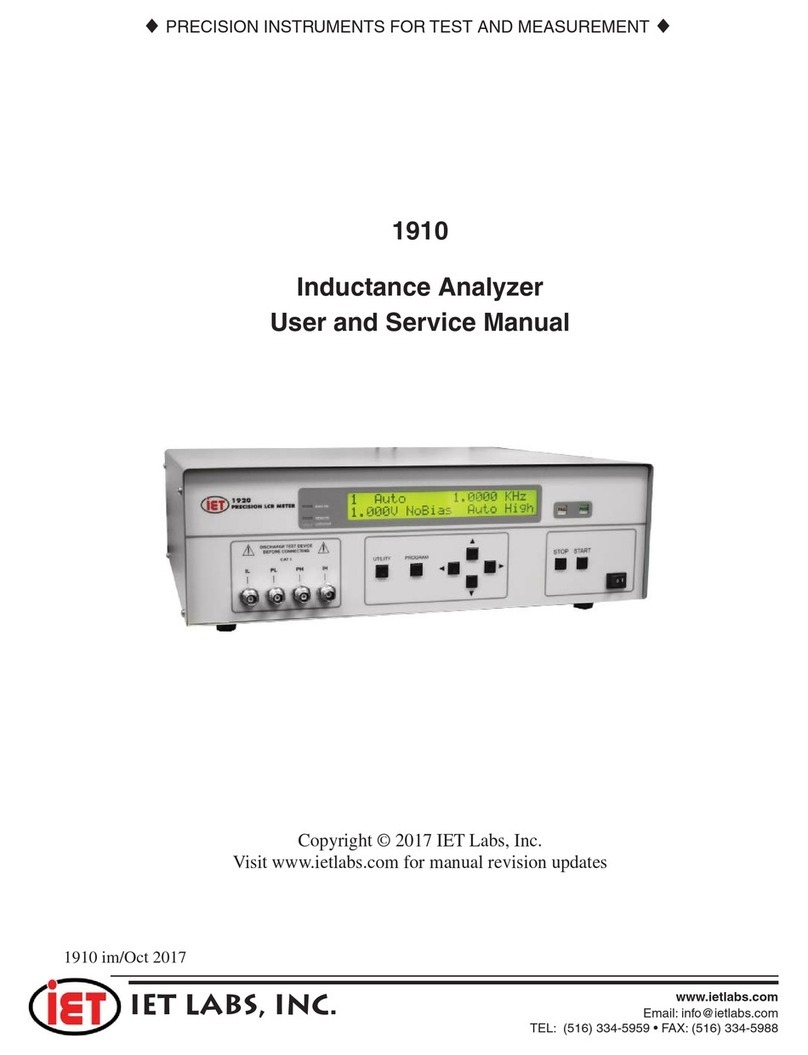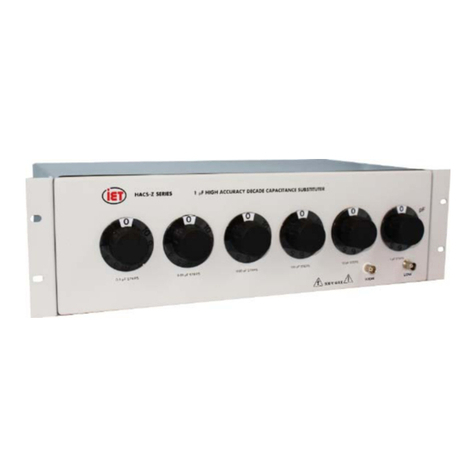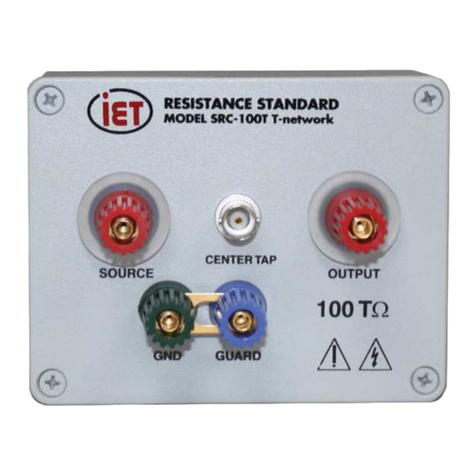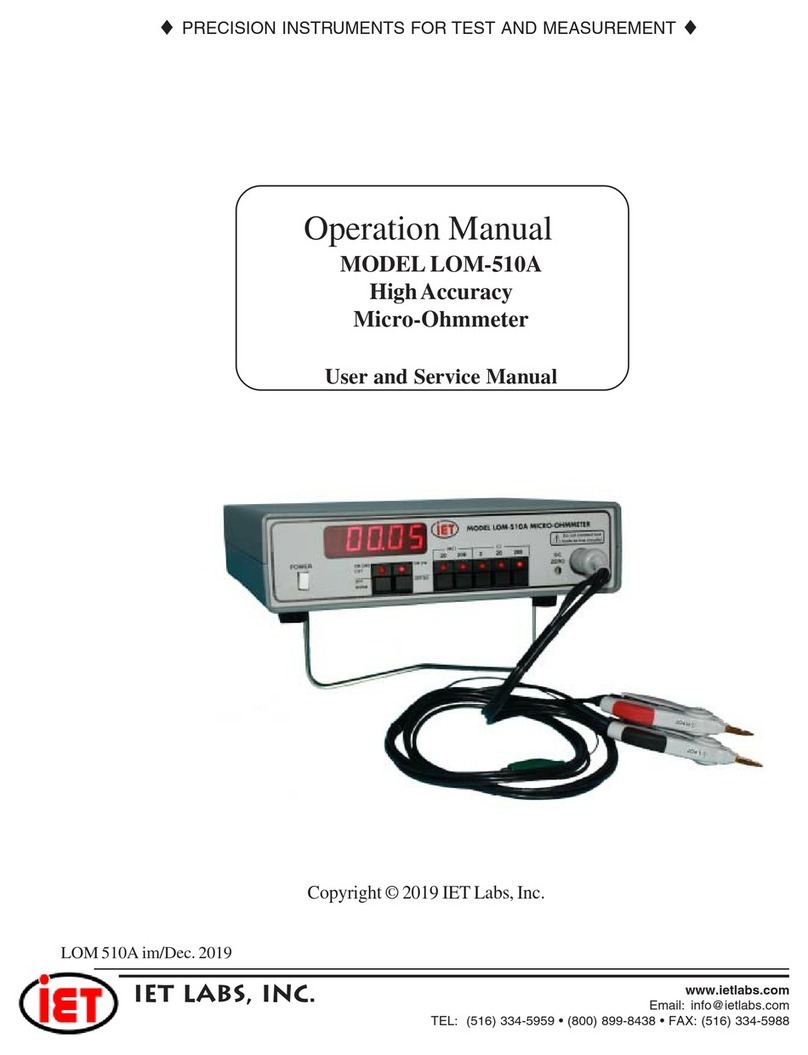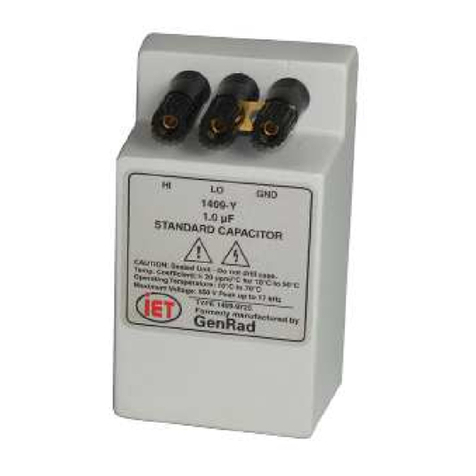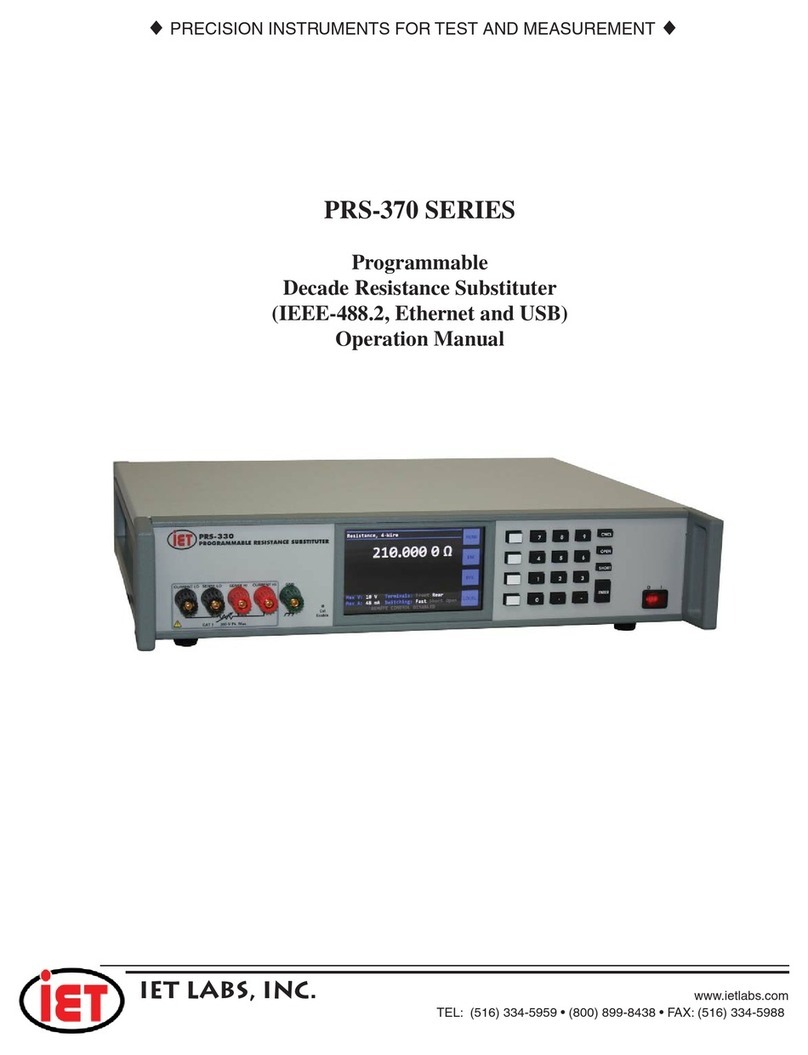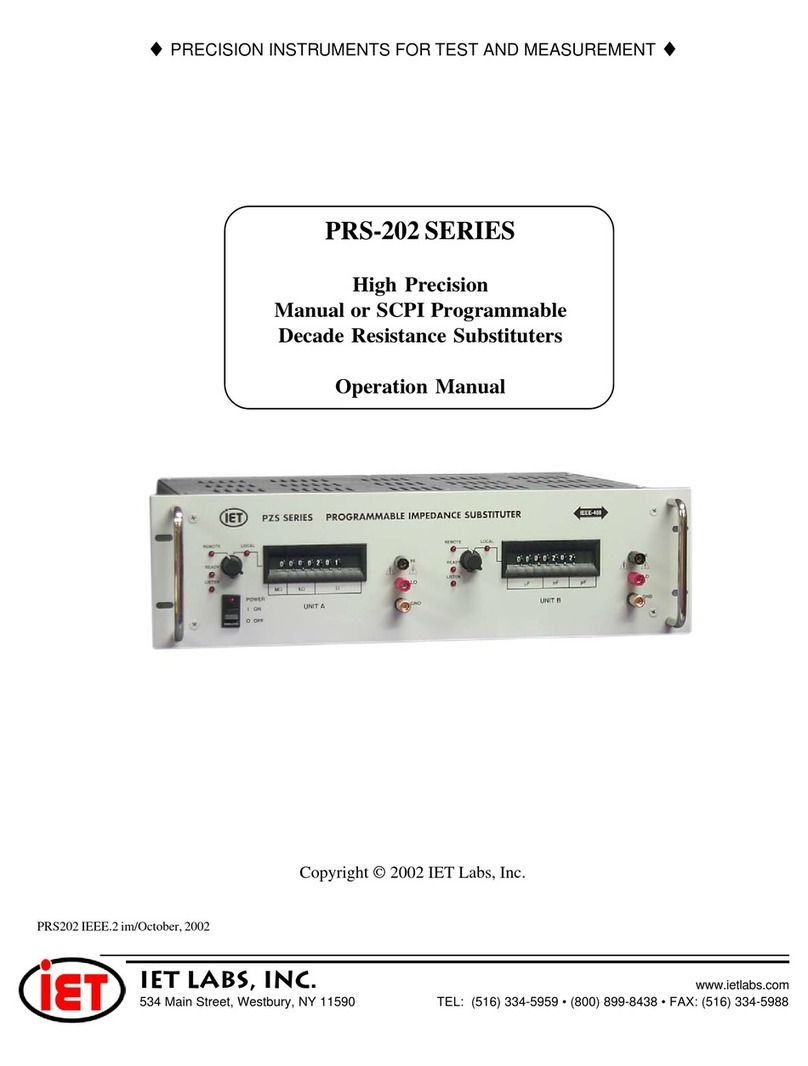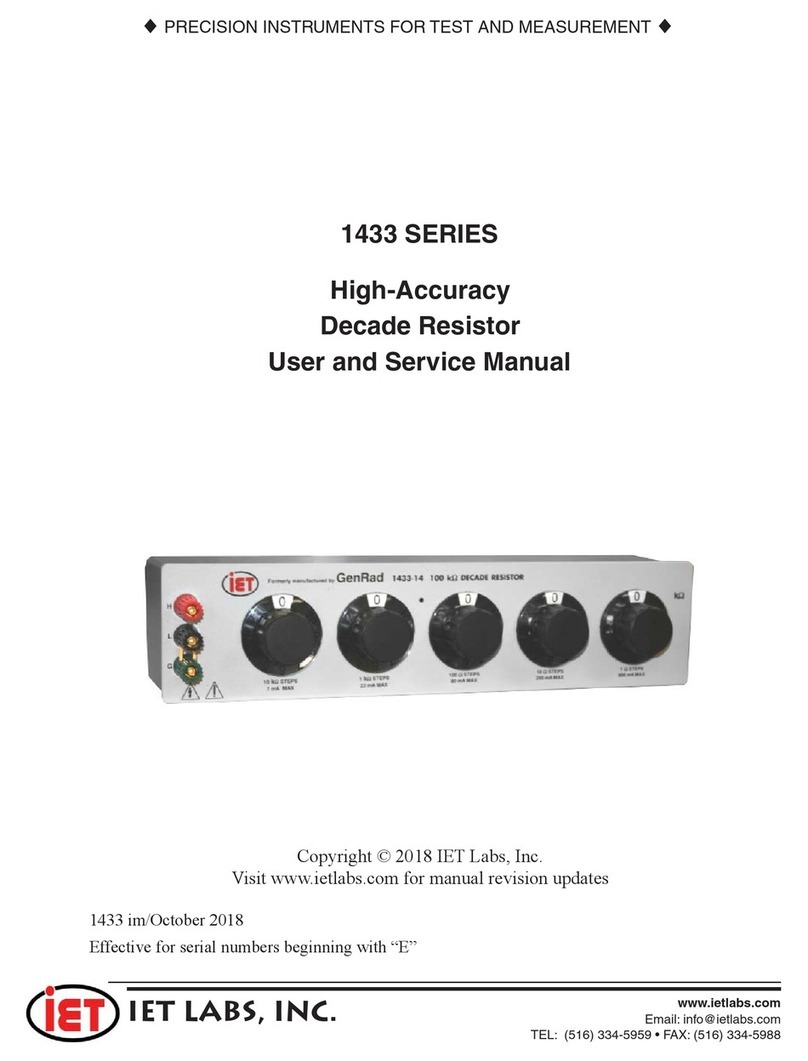
3
RS-925D
3Specifications
RS925D OPERATING GUIDE
MODEL: RS925D SN: D5-2307704
WARNING
IET LABS, INC. www.ietlabs.com
Accuracy
±(20 ppm+0.5 mΩ)
At 23°C "true ohm" measurement, 30-70% RH,
absolute reading, case grounded, SI traceable
No zero subtraction required
Minimum resistance:
10 mΩ ± 0.5 mΩ; determined by the lowest settable
position, “1”, of the 10 mΩ/step decade
Resistance repeatability:
Better than 100 µΩ, short-term, average value
Environmental Conditions:
Operating Temperature: 0°C to 55°C
Storage Temperature: -40°C to 70°C
Switch Type:
Multiple solid silver contacts; dust-tight diallyl-
phthalate body.
To allow continuous rotation, a blank position is
added on most decades.
Resistance
per step
Total
decade
resistance
Max
current
Max
power Temperature
coefficient
(±ppm/ºC)
Power
coefficient
(±ppm/mW)
Stability
(±ppm/yr) Decade positions Resistor type
whichever applies first
100 µΩdivision
20 µΩresolution 10 mΩ 2 A NA 20 1
20 ppm+0.5 mΩ
Continuous Rheostat
1 mΩ 10 mΩ 2 A NA 20 1 11 positions "0"-"10"
Resistance wire
10 mΩ 100 mΩ 2 A NA 20 1 10 positions "1"-"10"
(10 mΩ minimum reading
100 mΩ 1 Ω 2 A NA 20 1
11 positions "0"-"10"
1 Ω 10 Ω 1 A 5 W 20 0.4
Wirewound
hermetically sealed
low-inductance
10 Ω 100 Ω 0.33 A 5 W 10 0.3
100 Ω 1 kΩ 0.1 A 5 W 3 0.1
1 kΩ 10 kΩ 33 mA 5 W 3 0.1 10 ppm
(<5 ppm typical)
10 kΩ 100 kΩ 10 mA 5 W 3 0.1
100 kΩ 1 MΩ 3 mA 2,000 V peak 3 0.1 12 positions "0"-"11"
Wiring and switch resistance NA 50 µΩ/ºC 0.2 µΩ/W NA
For Best Performance:
Whenever the unit has been idle, turn each switch 7-10
times both ways before using. This switch "break-in"
procedure is standard metrology practice required for
best accuracy to remove any silver oxide fi lm on the
contact surfaces, typically <1 mΩ.
Terminals:
Four, 5-way, gold-plated, tellurium-copper
binding posts with low thermal emf and
low resistance, for four-terminal Kelvin
measurements, plus one binding post
connected to case for shielding. Rear outputs
are available as an option.
RS925D OPERATING GUIDE
MODEL: RS925D SN: D5-1645634
WARNING
IET LABS, INC. www.ietlabs.com
Accuracy
±(20 ppm+0.5 mΩ)
At 23°C "true ohm" measurement, 30-70% RH,
absolute reading, case grounded, SI traceable
No zero subtraction required
Minimum resistance:
10 mΩ ± 0.5 mΩ; determined by the lowest settable
position, “1”, of the 10 mΩ/step decade
Resistance repeatability:
Better than 100 µΩ, short-term, average value
Environmental Conditions:
Operating Temperature: 0°C to 55°C
Storage Temperature: -40°C to 70°C
Switch Type:
Multiple solid silver contacts; dust-tight diallyl-
phthalate body.
To allow continuous rotation, a blank position is
added on most decades.
Resistance
per step
Total
decade
resistance
Max
current
Max
power Temperature
coefficient
(±ppm/ºC)
Power
coefficient
(±ppm/mW)
Stability
(±ppm/yr) Decade positions Resistor type
whichever applies first
100 µΩdivision
20 µΩresolution 10 mΩ 2 A NA 20 1
20 ppm+0.5 mΩ
Continuous Rheostat
1 mΩ 10 mΩ 2 A NA 20 1 11 positions "0"-"10"
Resistance wire
10 mΩ 100 mΩ 2 A NA 20 1 10 positions "1"-"10"
(10 mΩ minimum reading
100 mΩ 1 Ω 2 A NA 20 1
11 positions "0"-"10"
1 Ω 10 Ω 1 A 5 W 20 0.4
Wirewound
hermetically sealed
low-inductance
10 Ω 100 Ω 0.33 A 5 W 10 0.3
100 Ω 1 kΩ 0.1 A 5 W 3 0.1
1 kΩ 10 kΩ 33 mA 5 W 3 0.1 10 ppm
(<5 ppm typical)
10 kΩ 100 kΩ 10 mA 5 W 3 0.1
100 kΩ 1 MΩ 3 mA 2,000 V peak 3 0.1 12 positions "0"-"11"
Wiring and switch resistance NA 50 µΩ/ºC 0.2 µΩ/W NA
For Best Performance:
Whenever the unit has been idle, turn each switch 7-10
times both ways before using. This switch "break-in"
procedure is standard metrology practice required for
best accuracy to remove any silver oxide fi lm on the
contact surfaces, typically <1 mΩ.
Terminals:
Four, 5-way, gold-plated, tellurium-copper
binding posts with low thermal emf and
low resistance, for four-terminal Kelvin
measurements, plus one binding post
connected to case for shielding. Rear outputs
are available as an option.
Figure 2-1: Typical Operating Guide Affixed to Unit
